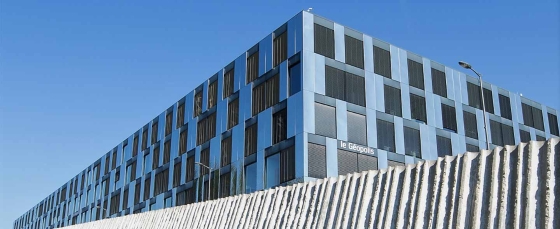University of Lausanne: Customer Story Key Figures
Holistic real-time energy management for the entire campus
11% reduction in heat consumption
Access to smart energy data from any device, anytime, anywhere
Sustainable future with intelligent energy monitoring
The University of LausanneEcoStruxure™ Power helps to achieve the goals of a 2000-watt society by 2040 — 10 years faster than foreseen by the Swiss Energy Strategy 2050.
Discover EcoStruxure Power
Learn how EcoStruxure Power can make your buildings more energy efficient and sustainable.
The Challenge
The University of Lausanne is a genuine small town. Around 15,000 students and 4,900 employees research, teach and work in 40 buildings on the campus in Lausanne. Last year, annual energy consumption was around 28 GWh of electrical and 20 GWh of thermal energy. This corresponds to the annual electricity consumption of 7000 households.
In order to become a 2000-watt society (Swiss Federal Council's Energy Strategy 2050), the university must replace all fossil energy sources with renewable resources and drastically reduce overall energy consumption. Energy consumption per person and year must be reduced to 2000 watts of continuous power, and CO2 emissions must be reduced to one tonne. For comparison: today's average long-term consumption in Switzerland is still around 5000 watts, and average CO2 emissions are 6.5 tonnes per person.
Before the energy consumption of the campus could be optimised, reliable data providing information about the actual energy consumption of the individual buildings at all times was required. In the beginning of its operation, the Unibat team, the service unit for the operation of all buildings, collected energy consumption figures each month by hand — and evaluated the data via an Excel spreadsheet. With over 250 meters for gas, water, heat, cold and electricity, this was a cumbersome undertaking.

The Solution
Achieve ambitious sustainability targets with EcoStruxure Power and monitoring
Edge Control: EcoStruxure Facility Expert - Energy
Connected Products: Acti 9 iEM3000 three-phase energy meters, PM3000 and PM5000 series universal measuring instruments, NSX M5E, NW M5E, NT M5E, Masterpact circuit breakers, PowerLogic EM4300 energy and power meters, EGX gateways, IFE ethernet interfaces, Com’X power data logger, PowerTag wireless energy sensor, AccuSine mains-filter
Our EcoStruxure Power architecture was used for the new "Géopolis" building inaugurated in 2013: networked circuit breakers and energy meters, communication gateways and a cloud-based energy management platform for data analysis. The result was intelligent monitoring that records energy distribution and consumption in real time and thus provides a broad database for energy-related decisions. Such detailed monitoring was urgently needed, because the building planned in Minergie®-ECO standard would have to meet particularly high energy efficiency requirements in the future - especially in terms of possible performance gaps in daily operation.
Setting up efficiency value targets for a building is much easier than achieving them in day-to-day operation. Buildings are complex, "living" organisms. A building has to be regulated so that the different trades are optimally coordinated with each other. This helps prevent, for example, the cooling machine from cooling when the heating system is running at the same time. In addition, the actual use of buildings can deviate from the planned use or change over time. Studies show that energy-optimized buildings, without monitoring, quickly return values that are worse than before optimisation. This is why continuous monitoring is so important.
The Results
Automated alarms and intelligent algorithms provide Smart Data. The Unibat team immediately sees when the energy consumption of a building deviates from the norm. Thanks to our monitoring solution, the team is now able to consistently identify performance deficits and gradually optimise the building's energy balance. For example, non-system-relevant energy consumers such as ventilation and heating are automatically shut down at weekends and at night to prevent power fluctuations.
• Holistic real-time energy management for the entire campus of about 30 buildings
• Access to energy intensity maps and graphs from any device, anytime, anywhere (Smart Data)
• Combined energy management and maintenance tools
Thanks to this digital energy monitoring, the University of Lausanne has been able to implement initial measures. Heat consumption has fallen by 11% over the last four years.
Based on these positive results, the University of Lausanne has decided to extend our monitoring solutions to all buildings on the campus. Right now, the 16 most important of the total of 40 buildings are digitally monitored and analysed; together they represent around 90% of the total consumption on the campus. Electricity demand, the power supply from its own 5,400 m2 photovoltaic system, gas heating, lake water cooling and water supply are all integrated.
In 2019, the University of Lausanne became the first certified 2000-watt transformation site in French-speaking Switzerland. Digital energy monitoring via the cloud platform was an essential step along this demanding path.
Loïc Furcy, Head of the Energy Group at Unibat
Customer Testimonial
"The University of Lausanne wants to be a pioneer in sustainability. That's why we want to make the campus a role model and become a 2000-watt site by 2040."
Learn more
Read more customer stories
Don't stop here. We've got lots of success stories to browse through.
Read moreDiscover EcoStruxure
Learn how your business can achieve success too.
Explore more







